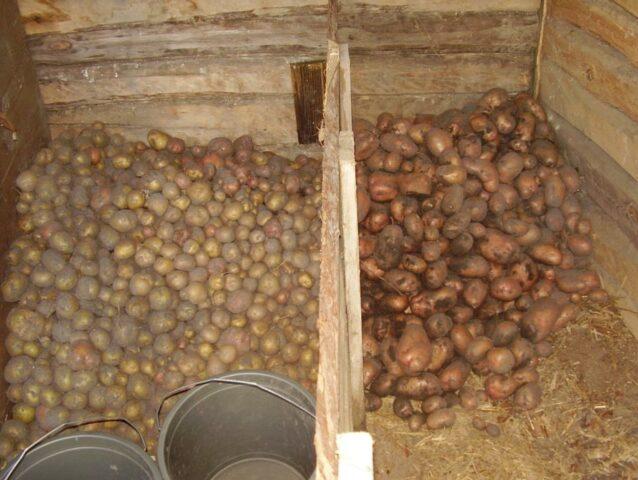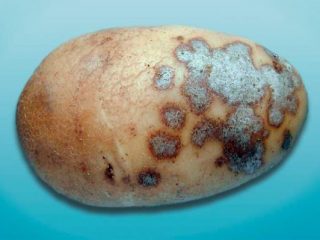Content
Gardeners value potatoes, not least for their good keeping quality, which is characteristic of many varieties and hybrids. However, this is not a guarantee that the crop will not spoil throughout the winter. Tubers need to be provided with optimal or close to optimal conditions, because potatoes freeze at temperatures slightly below zero if it lasts for several days. However, in some cases, tubers damaged by cold are “not hopeless”: they are quite acceptable to eat.
Optimal storage conditions
Potatoes that freeze in storage are a fairly common occurrence. But the risk of damage can be minimized if you provide it with optimal or close to these conditions and take care of the constancy of the parameters during the winter.
The list is quite short:
- lack of light;
- good ventilation (excluding cold drafts);
- containers that provide the possibility of air exchange;
- temperature 2-4 °C;
- air humidity 75-80%.
Most often, potatoes spoil due to inappropriate temperature. It can withstand a short change of 1-2 °C in any direction, but with a strong deviation to minus it freezes. At higher temperatures, potatoes begin to sprout and quickly “shrink”.

It’s not enough to harvest a good potato harvest – you need to be able to preserve it
How to tell if potatoes are frozen
The first sign indicating that the potatoes have begun to freeze during storage is a change in the sound of the tubers touching. When pouring, they knock against each other loudly, and not dully.
It is quite obvious that potatoes become frozen if you bring them into a warm place. After just 1-2 hours at room temperature:
- the peel wrinkles, darkens, becomes flabby, and breaks easily when pressed;
- tubers actively secrete watery juice both in their entirety and when peeling and cutting;
- The pulp turns brown or black when cut.

Essentially, when frozen, the pulp decomposes due to rot developing
At what degrees do potatoes freeze?
Even small negative temperatures with prolonged exposure to cold are destructive for potatoes. But it must be taken into account that, although it does not freeze instantly, certain negative processes begin already at 0 °C. The liquid contained in the pulp turns into microcrystals of ice, damaging tissues and dramatically accelerating the decomposition process.
At what temperature will potatoes freeze in the ground?
Undug potatoes freeze in the garden bed only when the temperature of the substrate at the depth of the tubers drops to -1.7-3 °C. Accordingly, the first frosts at the end of summer or early autumn, especially if they are short-lived, do not affect the quality of the crop. At this time, the soil maintains a temperature at least 5-10 °C higher, turning into a kind of “blanket”.
The substrate takes much longer to cool than air. In temperate climates, the soil freezes to critical values only by the end of November or the beginning of December, when not only nighttime, but also daytime subzero temperatures last for 3-4 weeks.

Regular loosening and mulching helps to retain heat in the soil longer.
At what temperature do potatoes freeze in a garage or barn?
Creating optimal conditions for potatoes in a garage or shed is problematic. It cannot be kept in these rooms in severe frosts. Potatoes freeze when stored at a temperature of -1.7-3 °C, and the indicators in a garage or barn and outside differ by literally 2-3 °C. Accordingly, it will deteriorate if the outside temperature reaches -4-5 °C.
You can “delay the inevitable” a little so that the potatoes do not freeze in the garage or shed by covering them with old blankets, warm clothes, and so on. This way they “gain” another 2-3 °C, but even for regions with a temperate climate, not to mention a more severe climate, this is not a panacea.

Garages and sheds are clearly not suitable for winter storage.
At what temperature do potatoes freeze on the balcony?
In the absence of glazing, this is also not an option for permanent storage in winter. Here we can say that the potatoes on the balcony froze as soon as the air temperature drops to -2-3 °C, subject to additional insulation - up to -4-6 °C.
On a glassed-in loggia you can store tubers at temperatures down to -8-10 °C. To do this, they are placed in cardboard boxes or wooden boxes, and foam plastic, blankets, and old clothes are placed on top for additional thermal insulation.
But even here you can’t be sure whether the potatoes on the balcony will freeze. For example, high humidity has a negative effect on this.

During the winter, tubers on the balcony can only be stored in a special “home” mini-cellar or boxes equipped with a heating system
At what temperature do potatoes freeze outside?
A fairly common way to store potatoes is in a hole on the street. The minimum depth to hope that it will not freeze in winter is 1.5-2 m.
The walls and bottom must be properly insulated, and a layer of mulch (dry grass, fallen leaves, straw, spruce branches) at least 35-40 cm thick is thrown on top. It is impossible to determine at what temperature the potatoes will freeze. The degree and rate of freezing of the substrate depends on its quality, looseness, the presence and duration of thaws, and other factors.

To preserve the consumer properties of tubers, it is necessary that they be below the soil freezing level to a temperature of -1.7-3 ° C
At what temperature do potatoes freeze in the cellar?
The most suitable room for storing tubers, which allows you to be pretty sure that the potatoes have not frozen during storage, is a cellar or basement. However, if the winter temperature drops to -30 °C or lower for a long time, it may turn out that the potatoes in the cellar are frozen. In extreme cold, it is advisable to store it in heated boxes - insulation in the form of foam plastic, blankets, and so on will not be enough.

In the cellar, it is easiest to ensure the required temperature, humidity, and other parameters to prevent damage to the crop
Is it possible to eat frozen potatoes?
There is a widespread belief that when potatoes freeze, substances harmful to human health are produced under the influence of negative temperatures. And, accordingly, after this it becomes unfit for food. However, this point of view is fundamentally wrong.

Cold provokes the breakdown of starch, in the process fructose and sucrose are released
Natural sugars are definitely not poisonous for humans: frozen potatoes can be eaten, although, of course, the taste of the food will be specific. The only exceptions are specimens severely damaged by frost, in which the flesh has turned into black or dark brown mucus.
What to do if the potatoes are frozen
If there is a suspicion that the potatoes are freezing before harvesting, the tubers must be dug up as quickly as possible. You can’t leave them in the garden in any case - they begin to rot, “attracting” pathogenic microflora and insects en masse.
The dug up tubers are left warm (15-18 °C) for several days to determine the degree of damage.If their skin retains color and their flesh retains texture, they are suitable for storage, although shelf life naturally suffers. Potatoes that freeze in the garden are kept separate from the rest of the crop and their condition is constantly monitored.
When the peel darkens significantly, it will not be possible to preserve the tubers, even for a short time. They need to be “processed” faster. And to make the specific sweetish taste that appears when potatoes freeze less pronounced, you can resort to one of the following methods:
- Leave the tubers in a warm place for a longer time (7-14 days).
- Immerse the potatoes in hot (40-60 °C) water for several hours. Then, when peeling, cut off not only the peel, but also a layer of pulp 5-8 mm thick.
- Keep the peeled tubers in cold water for about an hour. After that, change it, add table vinegar (1 tbsp per 2.5-3 l), salt and boil until tender.
- Prepare dishes from frozen potatoes, the recipe of which allows you to add spices and herbs in large quantities or eat them with sauces

Frozen tubers are a suitable “raw material” for casseroles, cutlets, potato pancakes, dumplings, filling for dumplings
Where else are potatoes used that freeze in the garden or during storage:
- for livestock feed;
- for the production of starch;
- as a “raw material” for moonshine.
Storage recommendations
In order not to have to decide what to do with potatoes when they freeze, it is necessary to take into account in advance the recommendations regarding their preparation for storage and the process itself:
- Varieties and hybrids of mid-late or late ripening are much more shelf-stable. They also demonstrate better cold resistance and are less likely to freeze in the garden and during storage.
- During early autumn frosts, the “heavy” substrate (clay, peat, silt) freezes most quickly. The situation is even worse when the bed is located in a lowland or at the foot. Accordingly, such areas are least suitable for planting tubers. Also, the experience of gardeners shows that potatoes freeze more often during storage if the summer was very rainy.
- The process of starch breakdown in tubers that freeze occurs most quickly if they have an excess of nitrogen combined with a deficiency of potassium. Therefore, it is important to apply the necessary fertilizers in a timely manner.
- You cannot immediately store potatoes and wash them before doing so. Drying it for 5-7 days at a temperature of 13-18 ° C contributes to the “coarsening” of the skin, which becomes additional protection from the cold. A similar effect is achieved by mowing the tops about 1.5-2 weeks before digging up the tubers.
- To prevent potatoes from freezing during storage, it is recommended to reduce the temperature gradually over a period of about two weeks. This is necessary to gradually “slow down” any biochemical and physiological processes; the potatoes become less susceptible to cold and temperature changes.
- Any diseases negatively affect the keeping quality and frost resistance of tubers. To reduce the risk of mold, rot, and other pathogenic microflora developing, the room intended for storing potatoes is first disinfected and dried.

Preparation for storage is no less important than optimal winter conditions
Conclusion
Potatoes freeze at temperatures slightly below zero, so without creating and maintaining optimal conditions in the storage area, it is impossible to preserve the crop during the winter. However, in some cases, tubers exposed to cold can still be “saved.”








